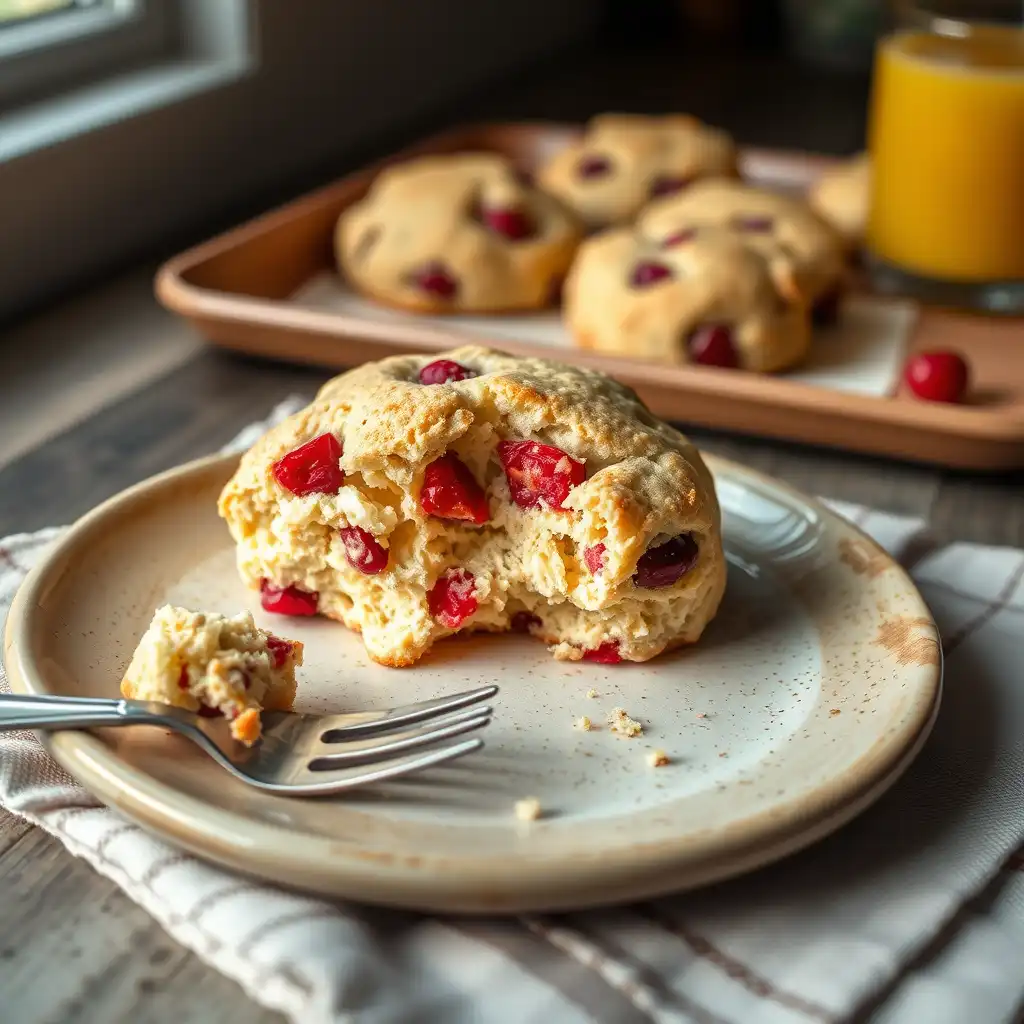The first time I tasted a scone that actually made me stop mid-bite and raise an eyebrow in surprise, it wasn’t in some posh tearoom in London. It was at a truck-stop café outside Vermont. It was crumbly, buttery, slightly tart, and it tasted like whoever made it gave a damn. That’s the kind of scone we’re talking about today. Not dry. Not bland. Not “fine.” This Cranberry Orange Sour Cream Scone is a showoff—it’s the golden child of the pastry world that wears citrus perfume and tart cranberry earrings.
This isn’t your average scone. It’s got attitude. Sour cream brings richness and a touch of tang. Orange zest slices right through that creaminess with brightness and lift. And cranberries? They pop with tart little surprises in every bite. These aren’t the boring dry hockey pucks you microwave and eat with regret. This is a proper, plush scone—with flaky layers, caramelized edges, and just the right chew.
It’s a recipe designed for professionals and serious home cooks alike, with technique at its core and flavor at the forefront. Let’s get right into it.
Ingredients & Substitutions
All-Purpose Flour (2½ cups)
Use a high-quality, unbleached all-purpose flour. If you’re tempted to swap for cake flour, don’t. You’ll end up with a scone that lacks structure. Bread flour’s too high in protein—makes it chewy, not crumbly.
Granulated Sugar (½ cup)
This isn’t a dessert-level sweet. Just enough sugar to balance the tart cranberries and zingy orange. If you’re watching sugar, coconut sugar will do, but it’ll darken the crumb and shift the flavor.
Baking Powder (1 tbsp)
Yes, a whole tablespoon. These need lift, and we’re not apologizing for it. Skip old baking powder—it loses oomph. Test freshness with hot water: if it fizzes, it’s good.
Baking Soda (¼ tsp)
Works with the acid from the sour cream and orange juice. Don’t leave it out or your scones will sulk and sit flat.
Salt (½ tsp)
Please don’t skip the salt. It’s the quiet backbone. Use kosher salt for better control, not iodized—too sharp.
Unsalted Butter (½ cup, very cold, cubed)
Frozen is even better. You want visible chunks in your dough—those melt in the oven and create those coveted flaky layers. Salted butter works in a pinch, but back off the added salt.
Full-Fat Sour Cream (¾ cup)
No substitutions here if you want the full experience. But if you must, Greek yogurt (full-fat) can mimic the tang, though it lacks the creamy richness.
Egg (1 large)
Room temp helps everything mix better. Straight from the fridge? Fine, but your dough might be harder to handle.
Fresh Orange Zest (zest of 1 large orange)
Bright, fragrant, and irreplaceable. Bottled orange extract? Please don’t. It tastes like bath soap.
Fresh Orange Juice (2 tbsp)
Just a splash—but it matters. Adds brightness. No concentrate. Ever.
Dried Cranberries (¾ cup)
Sweetened cranberries bring chew and tartness. If you have fresh or frozen ones, chop ’em roughly and toss with flour to keep them from bleeding.
Heavy Cream (for brushing)
Gives the tops that golden, glossy finish. Milk works but won’t give that deep color. Egg wash is a bit much here—stick to cream.
Step-by-Step Instructions
Cranberry Orange Sour Cream Scones Dough
Start with cold ingredients. That’s rule number one. Warm butter = dense scone. This dough wants to stay chill till the bitter end.
- Preheat oven to 400°F (200°C). Line a baking sheet with parchment. Not wax paper—parchment. Trust.
- In a large bowl, whisk together flour, sugar, baking powder, baking soda, and salt. You want even distribution before the wet stuff joins the party.
- Add the cold butter cubes. Now, get in there with your fingers or a pastry cutter. You’re looking for coarse crumbs—pea-sized bits of butter. Don’t overwork it. It should still look messy.
- Stir in cranberries and orange zest. Use a fork. They don’t need to be manhandled. Overmixing now is a death sentence for flakiness.
- In a separate bowl, whisk sour cream, orange juice, and egg. Pour over the flour mixture and mix gently with a spatula until dough just starts to come together. Shaggy is good. Shaggy is welcome.
- Turn the dough out onto a lightly floured surface. Knead it once or twice—only to bring it together. Pat it into a 1-inch thick disk. Not too thin or you’ll end up with biscuit crackers.
- Cut into 8 wedges with a bench scraper or sharp knife. Clean cuts = proper rise.
- Transfer to the lined sheet, spacing them out a bit. Scones spread, and you don’t want a scone blob.
- Brush tops lightly with heavy cream.
- Bake for 18–22 minutes or until golden on top and edges just begin to brown. The middle should spring back when touched—not squish.
Let them cool for a few minutes, but don’t wait too long. These sing warm.
Cooking Techniques & Science
Cranberry Orange Sour Cream Scones and the Science of Flake
This dough isn’t kneaded like bread. It’s barely mixed. Why? Because every bit of unmixed butter or loose flour becomes a flake in the oven.
Butter melts in the heat, creating steam pockets = flakiness. If you blend it too much, you end up with paste, not pastry.
Cold is king. Warm dough means melted butter before it hits the oven. That means no steam. That means no flake. Freeze your butter, chill your dough, maybe even your flour if it’s hot in your kitchen.
The sour cream is sneaky genius. It adds moisture without flooding the dough and gives a gentle acidity that plays nice with the baking soda. It’s what makes these scones rich, but not greasy. Moist, but not gummy.
Cutting the dough into triangles? That’s not just tradition. It helps with even baking. Circles or drop scones work, but you’ll lose the crisp edges and get more softness.
Serving & Pairing Suggestions
Cranberry Orange Sour Cream Scones on the Table
These scones don’t need much. A slather of salted butter or orange marmalade, maybe. Clotted cream is overkill. Let them shine.
Serve them slightly warm with coffee (a nutty Ethiopian or floral Darjeeling is ideal). If you’re feeling extra, a drizzle of orange glaze (powdered sugar + orange juice) can add a dessert-like finish.
Want a savory contrast? Try with a slice of sharp white cheddar. Trust me. That sweet-tart-citrus combo + salty cheese? Big win.
Serve alongside a light brunch—arugula salad, poached eggs, or even smoked salmon. They cut through richness like a pro.
Freeze leftovers (if you have any) and reheat in a 300°F oven for 8 minutes. Microwave? Only if you want sad bread.
Conclusion
Cranberry Orange Sour Cream Scones aren’t just another recipe—they’re a whole experience. They balance tender and crisp, tart and sweet, rich and fresh. They demand care but not perfection. And when you nail them, they’ll ruin every store-bought scone you ever eat again.
For professionals, these scones offer versatility in a pastry case, seasonal appeal, and reliable prep. For serious home bakers, they’re the kind of weekend bake that earns compliments, even from your grumpiest friends.
Use good butter. Don’t skimp on zest. And above all—keep it cold. Always cold.
FAQs
Can I use fresh cranberries instead of dried?
Yes, absolutely. Just chop them coarsely and toss them with a bit of flour before folding them in. This helps prevent them from bleeding too much into the dough.
Why did my scones come out dry or crumbly?
Most likely, you overmixed the dough or overbaked them. Mix just until the dough comes together, and bake only until the tops are golden and springy to the touch.
Can I make these scones ahead of time?
Yes. Shape the scones and freeze them unbaked on a tray. Once frozen solid, transfer to a bag. Bake from frozen, adding 2–4 minutes to the bake time.
What can I use instead of sour cream?
Full-fat Greek yogurt is the closest swap. It offers tang and moisture but lacks the richness. Avoid low-fat options—they’ll mess with the texture.
How do I store leftover scones?
Keep them in an airtight container at room temp for up to 2 days. Reheat in the oven, not the microwave, to preserve texture.

Olivia P. is a seasoned food blogger at Tastywink, sharing delicious, easy-to-follow recipes inspired by him passion for home cooking. With years of culinary blogging experience, he brings flavor, creativity, and a personal touch to every dish.
